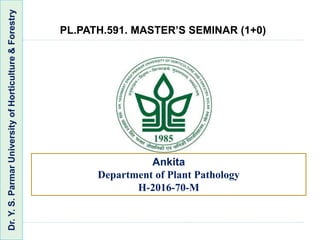This document discusses the topic of pathogenomics in plant pathology. It begins with an introduction to key terms and techniques used in pathogenomics such as marker genes, effectors, and high throughput gene sequencing. It then discusses the role of effectors in pathogenesis and host-pathogen interactions. It provides examples of pathogenomic studies on various pathogens such as Puccinia graminis f. sp. tritici (wheat rust) and Xanthomonas axonopodis pv. manihotis (cassava bacterial blight). It discusses how pathogenomics can help develop diagnostic tools, provide durable resistance to plants, and uncover plant processes through analysis of pathogen genomes and effectors.



































